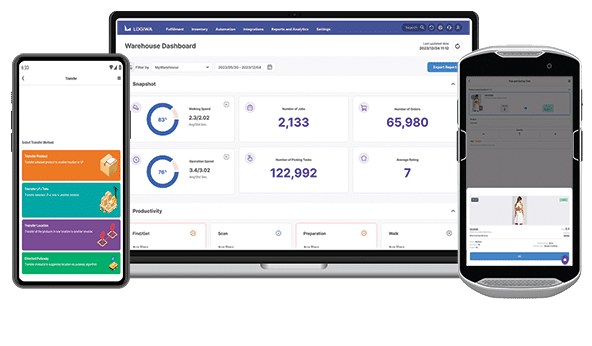We’ve rounded up 11 tips and tricks for a successful peak season in the warehouse that will keep your operations running as smoothly and efficiently as possible.
Contents
- Be Prepared for Peak Season in Warehousing
- Prioritize Labor Planning
- Fulfillment Operations in Peak Season Warehousing and Optimal Warehouse Layout
- Clean up Your Picking Processes
- High-Efficiency Packing
- Test Inventory Accuracy
- Test your Shipping and Delivery Strategy
- Make Customer Retention a Top Priority
- Use Data to Your Advantage
- Embrace Reports for Your Fulfillment Operations in Peak Season
- Don’t Forget About Your Supplies
1. Be Prepared for Peak Season in Warehousing
You’re probably aware that peak season warehousing starts earlier and earlier every year. Back-to-school sales kick off in early August, and before the Halloween pumpkins are rotting on our doorsteps, the Christmas ads start on TV.
November has just started, and if you haven’t been thinking about Black Friday or Cyber Monday yet, it’s time to get started. Recent reports show that, due to the current economic situation in the US, consumers started thinking about, or have started, their holiday shopping already. In fact, half of holiday shoppers started their shopping before Halloween.
Now is the time to ensure your shelves are stocked with popular items and to get this year’s “must-have” gifts on your shelves. Review your historical data to determine what you need more of and the extra labor resources you’ll need in the coming months. Ongoing supply chain issues could leave you with empty shelves if you don’t plan ahead.
2. Prioritize Labor Planning
If you haven’t started your search for more employees to meet the increased demands on fulfillment operations in peak season, it’s time to start. Trying to hire more employees in the middle of peak season will only leave you scrambling, as it takes time to get new employees onboarded and trained. If you use warehouse robotics or other specialized tools or equipment in your warehouse, you may need extra time for training, so don’t forget to consider these factors when working on your peak season labor planning.
Not only will having enough staff available help you meet the increased demand, but it will also help improve safety for everyone by preventing overworking and employee burnout.
Take a look at our Warehouse Labor Planning Template to help estimate the number of workers and labor hours you will require for picking and packing.
3. Fulfillment Operations in Peak Season Warehousing and Optimal Warehouse Layout
How long does it take for an employee to find an item in your warehouse?
As you know, the longer it takes to pick items, the longer it takes to get orders out the door. Inefficient warehouse layouts or putaway methods can drastically slow down your order completion time, and as they say, “time is money.”
Before you bring in more inventory to stock your shelves for peak season, take some time to review your warehouse layout. Make use of put walls, zoning, and walking path optimization methods. Sometimes just rearranging the placement of your packing or shipping stations to keep all warehouse processes functioning with absolute efficiency can resolve bottlenecks in your operations.
Creating an intelligent scheme for where different products are stored makes every subsequent task—picking, packing, and shipping—more productive, and intelligent software systems can help with this process.

4. Clean up Your Picking Processes
When it comes to labor costs, picking and packing processes can be one of your highest costs, especially when it comes to peak season warehousing—finding efficiencies in these areas before peak season will help you reduce costs while ensuring order accuracy and getting orders out the door quickly.
If your employees are often wandering aimlessly through your aisles picking items, now is the perfect time to implement new picking processes based on your operation:
-
- Discrete order picking/single order picking: A picker receives a task to pick an order. Pickers pick the items explicitly for that order. They pack it, ship it, and then repeat.
- Batch picking: Orders are grouped into batches based on some attribute of theirs. Pickers will pick those in larger groups before returning to the packing station.
- Wave picking: Orders are released to warehouse staff in waves based on similar attributes, such as shipping date, types of items to be picked, or location in the warehouse.
- Zone picking: Similar to an assembly line process and more of a location-focused method. Pickers are assigned to specific storage zones in the warehouse, and orders are sorted and packed after picking.
If you’re planning to implement voice or mobile picking technology into your operations, taking action early allows you to train employees and ensure the technology works properly, paving the way for success when warehousing in peak season.
5. High-Efficiency Packing
Regarding packing processes in peak season warehousing operations your ultimate goal should be to ship orders on time with the minimum number of pickers to minimize your labor costs. Begin by gaining a deep understanding of your processes, your bottlenecks, and which of those are inside of your control, and then implement plans to improve them.
Using a warehouse management system, packing errors can be drastically reduced by:
-
- Scanning each item into the system so workers can see any other items that should be packed in the same customer order.
- Selecting an appropriate box and scan the box or enter its code into the system.
- Printing a packing slip and, if the warehouse has a label maker, printing an address label to be affixed to the box.
6. Test Inventory Accuracy
Doing a complete count of all your inventory is important before peak season! This ensures your records are accurate, items are in the appropriate location, and that you have time to reorder items as required.
Using a WMS will ensure ecommerce channels have accurate inventory information, preventing “low stock” or “out of stock” messages for customers. Additionally, software tools will improve your replenishment processes by reacting to live data, allowing you to avoid setbacks before they occur and reduce shopping cart abandonment.
Refresh yourself on critical formulas related to best practices in inventory control, such as Days in Inventory and Average Inventory, which will also make forecasting easier as your peak season warehousing operations ramp up.
7. Test your Shipping and Delivery Strategy
Shipping and delivery delays are customers’ worst nightmare, especially during the holidays. An essential piece of your peak season warehousing plan should include evaluating your shipping and delivery processes.
Not only do you want to save money on shipping and delivery, your clients and customers do too! Using WMS software and smart shipping tools allows you to connect to many of the popular carrier companies, and to shop for the best rates possible. Additionally, integrations let employees print all the critical documents required to quickly get orders out the door, such as packing slips, and can help reduce shipping costs by finding the best box or envelope for your orders.
8. Make Customer Retention a Top Priority
Increased customer demands during peak season warehousing leave little room for error. Adopting warehousing best practices will make it easy to keep customer retention efforts a top priority in the coming months. This includes optimizing order accuracy processes, minimizing returns, and being prepared for potential post-purchase issues.
Why does customer retention matter during the busiest time of year? According to research from Bain & Company and Harvard Business Review, keeping customers happy makes them 14 times more likely to shop with you again. Improving customer retention rates by 5% can lead to a 95% increase in profits.
9. Use Data to Your Advantage
If you’re using any software in your warehouse operations, the data contained within can be a great resource when planning for warehousing peak season. From the number of orders picked, packed, and shipped in previous years, return rates, employee hours, and even the number of times you replenished an item can help you prepare your fulfillment operations in peak season.
Watch our Quick Takes webinar for more info about data-driven fulfillment operations.
10. Embrace Reports for Your Fulfillment Operations in Peak Season
If you’ve used your historical data to prepare for retail peak season, it’s also important to keep using that data throughout your peak season warehousing operations to keep your operations running smoothly. Regular productivity reports can help you uncover inefficiencies in your receiving processes or to resolve bottlenecks at your picking and packing stations. Your WMS will be able to create these reports on demand or at regular intervals to help identify issues before they become bigger problems.
11. Don’t Forget About Your Supplies
Sure, your shelves are stocked, but do you have everything you need to complete the order fulfillment cycle? Running out of printer ink, boxes, or mailers in the days between Black Friday and Cyber Monday will put a significant damper on your operations.
Think about your big pieces of equipment when planning for peak season in the warehouse: do you have enough shelves and racking to store everything? If a printer breaks, do you have a backup available? Do you have packing stations set up to help you meet the additional demand?
Peak season warehousing is just around the corner, and the time to prepare and optimize your operations is now. Ensuring your warehouse runs optimally is essential to keep your retailers, brands, and customers happy throughout the next few months and beyond.
For a full breakdown of how to prepare your fulfillment operations for peak season, download our 2022 Peak Season Warehousing Playbook.
If you have questions about how WMS software can help during peak season and year-round, reach out to a member of our sales team, or request a demo.





